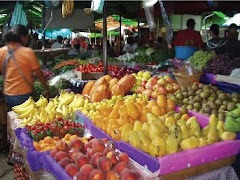While we were waiting for the boat to be launched back in the water, all the other boaters in our marina except Angelina left the river, so it was getting a bit boring. We, along with Rodney and Katrina, decided to take an inland trip. One of the places many cruisers have on their list is a visit to Semuc Champey, a natural monument in Alta Verapaz, in the middle of Guatemala. It is a natural bridge in a valley, above which are several stepped, turquoise pools, and is best experienced when there has been rain, so we figured this would be a great time to visit.
One website states that Semuc Champey is becoming a popular site to visit, but can be a little difficult to get to. Boy, is that an understatement! We made reservations on the van from Rio Dulce to the Mayan town of Lanquin, which is close to the monument. We were picked up at noon and joined by four young backpackers, from Slovenia, Germany, Israel, and Austria. (We are always amazed at the number of young persons from all over the world who set off, frequently by themselves, to backpack across Central America.) About 45 minutes into the trip, we turned off onto a gravel/dirt road which wound itself up into the mountains. With all the recent rains, the road was rather bumpy, and there are no guard rails on the side of the road overlooking deep drops in the hillside. Since there was no A/C on the van, the windows had to be opened, making for a rather dusty ride.
After about two hours, the van turned into a guarded, fenced compound, which turned out to be a camp where the workers in the near-by nickle mines lived. We were discharged and our luggage taken off the van. We met up with another group of young travelers on the way from Lanquin (our destination) to the Rio Dulce. Their van had broken down, and somehow they were brought to this camp, after what they described as a harrowing six hour journey. They were loaded into our van, which then turned back the way we had come. We sat for about an hour until a pick-up truck arrived, on which they started loading our bags. Katrina and Pat, as the two "older" women, sat in the front, and the other six climbed into the back. The driver, who spoke only Spanish, was one of the mine workers who lives in Lanquin and was on his way home for his once or twice per month visit. We spent the next four hours on a very narrow muddy road full of ruts and potholes. The driver honked the horn, or flashed his lights after dark, whenever he came to a curve, to let oncoming traffic know he was there. Several times, one vehicle had to back up until there was room to pass. The driver frequently shifted into 4-wheel drive, causing us to wonder how the ordinary vans ever made the trip. Bill and Rodney and the other four had to stand up holding on to railings on the truck, as it was too bumpy and uncomfortable to try and sit in the truck bed. We were about 20 minutes from our destination, after dark, when we came to a small village where they were having a religious parade in the middle of the road. About 40 men, women and children were holding candles accompanied by several others who were carrying a "float" with a statue of Christ carrying the cross or swinging pots of smoke. They would kneel down while the leader read passages from a book, and then they would stand and walk slowly forward while singing. After doing this four times in complete darkness except for their candles, as there was no electricity in the town, they finally came to a place in the road where they could step aside to let us through. They were Mayan Christians performing the parade for Lent.
 |
BB court at Nickle mine camp
|
 |
| Taking a break on a bridge |
 |
| View from the bridge |
We finally made it to our destination, El Retiro Lodge in Lanquin, about 8:00 P.M. After a buffet meal in the dining room, we were directed to our rooms. Rodney and Katrina were lucky to get the last room with a private bath, while we got a private "hut" with one "matrimonial " bed, a small table and a bookcase. The group toilets and showers were a short walk up stone steps. The backpackers usually stay in dormitories for 6 to 12 persons.
 |
| Our private abode |
 |
| Our room the first night at El Retiro Lodge |
 |
| One of the sinks outside the showers |
 |
| Truly a "throne," up 3 steps over septic tank |
The next morning, we saw that we were in a beautiful, riverside compound of palapas and wood buildings. The open-air restaurant and bar down by the river served adequate food and was a fun gathering place for people from all over the world, the four of us being the oldest. The second night, we were able to get a room with private bath, so didn't have to climb up the outside stairs to the toilet.
The morning after we arrived, we signed up for a tour of Semuc Champey. That adventure to follow.










































